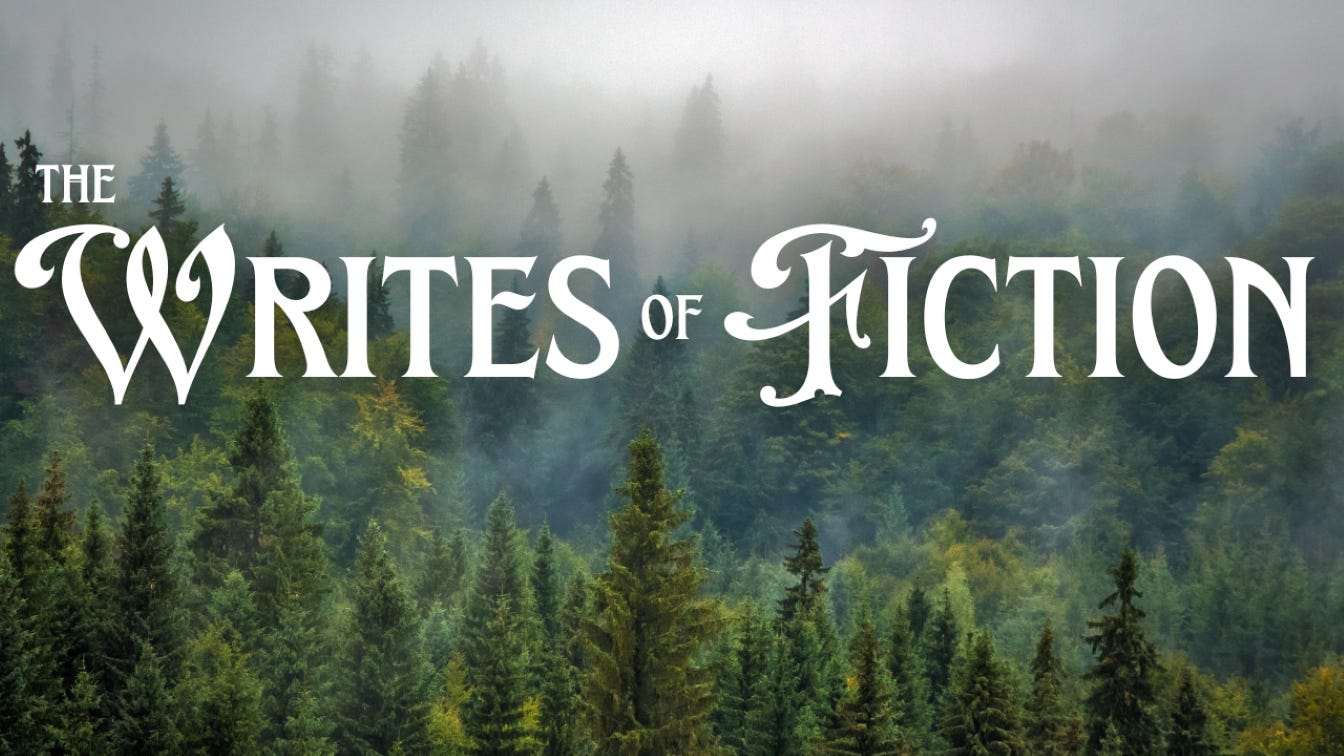Small rules, big impact
Writing techniques for novelists: sharing your unique creative voice, what your submission packet really needs to prove, mastering the semicolon, and the value of telling your story to yourself.
Sometimes the most profound writing wisdom comes in the smallest packages. A collaborative zine featuring "Five Rules to Live By" from eighteen different creative voices caught my attention this week—not for its analog charm, but for how each piece of advice connects to the fundamental challenges every fiction writer faces.
’s reflection on the project perfectly captures why these bite-sized insights hit so hard.Take Nina Veteto's rule: "Wonder. Resist naming. Lean into questions." I see too many authors rushing to label their work before they've discovered what their story is actually about. Sometimes the most powerful thing you can do is sit with the questions a little longer.
Or Lian Cho's battle cry: "Rewrite, rewrite, REWRITE!!!" Your first draft isn't precious—it's permission to begin. The magic happens in revision, where you discover what you were really trying to say.
Here's what struck me most about Dan's reflection: his willingness to let this small zine change his entire newsletter's direction. He'd planned to mention it briefly and move on; instead, he followed his curiosity to see where it led. In fiction, we call this following the story rather than forcing it into predetermined shapes.
What are we following in this issue of The Writes of Fiction?
5 rules for sharing your unique creative voice
What your query, synopsis, and first pages really need to prove
How to master the semicolon
The value of telling your story to yourself
Office Hours this Thursday!
Office Hours brings writers together to chat about writing and storytelling strategies. Spend a whole hour with me and my buddy Beth Hill (The Magic of Fiction) covering your questions about writing fiction. We typically tumble into impromptu classes on the issues we’ve recently been editing, coaching, and writing about, so come discover something new about writing with us.
📅 Our next Office Hours call is Thursday, May 29 at 1:00 p.m. US Central.
Office Hours happen every other month on the last Thursday of each month at 1:00 p.m. US Central. Log-in details go out to premium members next week.
Subscribe now to join in. To upgrade your free Writes of Fiction subscription (only $8 a month—a monthly coffee date for writers!), follow these steps.
And if you’re reading this but don’t subscribe yet: Hit the green button below and choose a paid subscription.
Five creative rules to live by
5 Rules for Sharing Your Unique Creative Voice:
Recognize that your voice is unique.
Your passion is your biggest credential.
Your voice is the respite that someone needs.
Share with a sense of curiosity and exploration.
How you share is a craft.—Read other contributor’s creative rules via Dan Blank at The Creative Shift.
More on giving yourself the chance to be creative: When writing is a habit and not a goal, you don’t have to rely on willpower or the muses to get you into the writing chair. “According to researchers at Duke University, habits account for about 40 percent of our behaviors on any given day,” writes James Clear, author of Atomic Habits. “Understanding how to build new habits (and how your current ones work) is essential for making progress in your health, your happiness, and your life in general.”—Read more at Giving yourself the opportunity to write.
What your query, synopsis, and first give pages really need to prove
You’re not being asked for a summary because agents want to ruin the twist. They’re asking because they need to know the story delivers on what it promises. That it doesn’t meander, collapse in act three, or end with the protagonist waking up to realize it was all a dream. That the main character doesn’t die out of nowhere. That the villain isn’t defeated by luck, fate, or a loophole. That the arc builds, crests, and lands with force.
The synopsis is where we look for the scaffolding. If it’s not there, we know the story won’t hold, no matter how beautiful the prose is.—Read the rest from Tiffany Grimes at Burgeon Design and Editorial.
More on querying: One of the most important things you can do to sell a novel is to quit fussing over it and start working on your next book.
You need more experience writing novels. Practice really does make perfect, and you undoubtedly now realize how long it takes to write one. Keep writing.
You need more manuscripts to offer. An agent may not like the novel you pitched, but they’ll fall in love with the one you wrote year before last. Keep writing.
You need to show you’re a bankable asset. Do you have the tenacity to turn out full-length novels again and again? Prove it. Keep writing.
—Read more at How long to query your manuscript.
Semicolons: The elegant link between sentences
Are you ready to elevate your writing? Meet the semicolon—the punctuation mark that is sophisticated, subtle, and often misunderstood. If you have ever wondered how to elegantly link related ideas without resorting to clunky conjunctions, the semicolon is your secret weapon.
Imagine strolling through an art gallery. Each piece is distinct, yet the rooms are beautifully connected in a way that creates a flowing narrative. That is what a semicolon does for sentences. It joins ideas that are related but independent, like connecting two rooms in the same exhibition.—Keep reading at English Enjoyed.
More on making connections in your writing: Many authors look at writing a manuscript as a suspended moment of almost mystical creativity. Experience shows that you get out of the process what you put into it—including the entire prewriting process.
Here’s the thing. Writing, prewriting—it’s all creative development. There’s nothing innately mundane or stiff or uncreative about developing a story using a spreadsheet, or a notebook, or a floor covered in index cards, or a wall covered in sticky notes.
Or a manuscript.
All these tools and methods are homes and handholds for your ideas. None of them is innately more creative than another.—Keep reading Prewriting: 6 parts of the writing process that aren’t writing.
Tell your story to yourself
Summarizing your story on a scene-by-scene basis helps you figure out how it should flow without getting distracted by the actual text of the novel.
And this isn’t just for plotters—pantser can benefit from it, too, because it’s a revision technique, not a drafting technique. (Although it is also useful for plotting).
During a revision, it’s easy to get caught up in what’s already there that we don’t always consider what’s best for the book. We think, “How can I work in that scene I love? This critical chapter needs to stay. That great dialogue exchange should move to chapter five.” We don’t explore how to improve the story—we only look at how we can make what we’ve already written better.—Read more from Janice Hardy’s newsletter.
More on revision and editing: Knowing when a manuscript is ready to be sent off for editing is fairly straightforward. The manuscript should be thoroughly revised, incorporating a close review of the plot, character arcs, story, and writing, outside feedback, and a healthy dose of author-powered proofreading. The manuscript you submit for editing should be the very best ambassador of your storytelling and writing abilities it can possibly be.
Knowing when you yourself are ready for editing may seem less obvious. You could choose to approach editing as a brief but unpleasant course of medicine you should hold your nose and chug as quickly as possible. Or you could choose to make more of it, as a relatively rare window allowing you to peer inside your writing in a new way. You, as a writer, are ready for editing when you’re warmed up and ready to grow.—Read more in When are you ready for professional editing?
Fiction Fuel
What separates good work from great isn't talent but persistence.
The most successful people aren't those who feel motivated all the time; they're the ones who work even when they don't feel like it. Too often, waiting to feel ready means never starting.
Outliers act despite their feelings, not because of them.—Farnam Street
Know the why
Whether you're crafting query letters, wrestling with semicolons, or figuring out how to share your work with the world, the fundamentals remain the same. Your story needs to be clear to you before it can be clear to anyone else. Master the mechanics so they support rather than distract from your voice.
The best writing advice isn't about following formulas—it's about understanding why the rules exist, then using them with intention. Your unique voice deserves that level of craft.
Onward,
Lisa
Need a quick storytelling tune-up? An early assessment offers a way to see what's working brilliantly and what needs attention before you take your next steps. Look over the different ways I can help, then book a session with me—let’s get your book moving forward.
This is The Writes of Fiction, a slow-simmered assortment of old and new thinking about writing fiction, assembled at my desk, not by algorithm. Help keep it going by becoming a paying subscriber.
And this is how I take a break from typing, enforced by editorial assistant Bus. 👇






